African Wind Power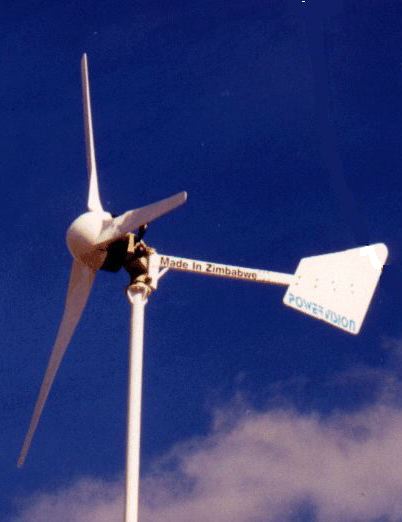 3.6m diameter wind turbine
3.6m diameter wind turbine
Here is some further information about the 3.6. See also the Powervision
page. The wind turbine is available in battery charging format for 12,
24, 48 or other voltages as required. A high voltage version with
transformers is being tested. Pumping versions are planned.
"Nothing tells you more about
a wind turbine's potential than rotor diameter."
- Paul Gipe
-Wind
Energy
basics, Chelsea Green 1999
Power curve
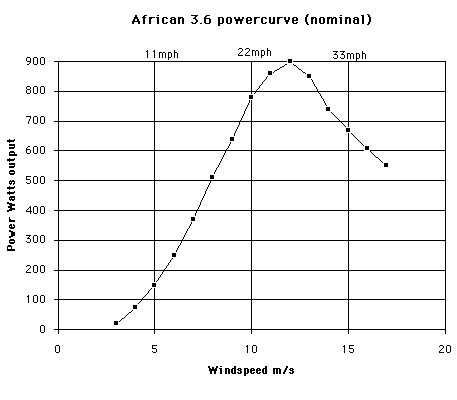 Here
is the nominal power curve for the 3.6 machine. Power curves vary
between different voltages, and there have not been sufficient funds to
produce a complete set of data, but we are working on it.
Here
is the nominal power curve for the 3.6 machine. Power curves vary
between different voltages, and there have not been sufficient funds to
produce a complete set of data, but we are working on it.
Notice that the diameter of the machine is large compared to it's
maximum
power output, and this gives it the torque to deliver good power in
lower
windspeeds, when other machines are unable to catch as much wind.
We believe it is more important to have a steady, day to day supply of
amphours into the battery, than to have a high peak-power rating.
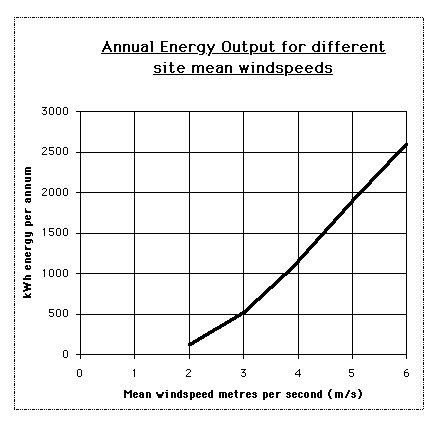
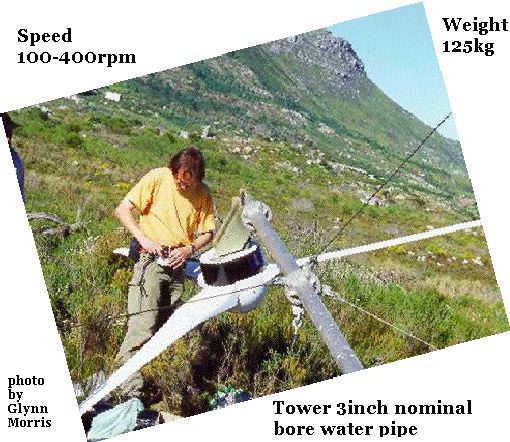 This is
a 'heavy metal' wind turbine, built for low speed and long life.
In this picture you can see the alternator (black) and the 3 blades
(white).
The tail had not yet been attached to this unit. Assembly usually
takes place at ground level, and then the tower is erected using a
simple
hand hoist (Tirfor). The tower is supported by steel wire guy
ropes.
This is
a 'heavy metal' wind turbine, built for low speed and long life.
In this picture you can see the alternator (black) and the 3 blades
(white).
The tail had not yet been attached to this unit. Assembly usually
takes place at ground level, and then the tower is erected using a
simple
hand hoist (Tirfor). The tower is supported by steel wire guy
ropes.
Evolution
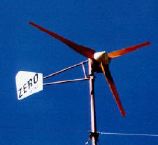 First
built
for Zimbabwe Energy Research Organisation (ZERO) by Manx
Wind Energy Services
First
built
for Zimbabwe Energy Research Organisation (ZERO) by Manx
Wind Energy Services  (consultants)
in 1996, the wind turbine design was commercialised by
African
Windpower of Harare and badged the pt3600. Detailed design
has
been by Scoraig
Wind Electric throughout.
(consultants)
in 1996, the wind turbine design was commercialised by
African
Windpower of Harare and badged the pt3600. Detailed design
has
been by Scoraig
Wind Electric throughout. 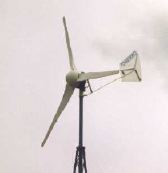
The wooden blades of the original were replaced by fibreglass, and
the tail was simplified.
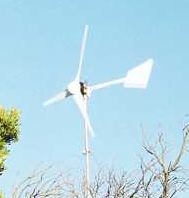 On
the left is a 1999 production unit from Powertronics. Tens of
machines
have been produced for local customers in Zimbabwe and the export
market.
With the new African Windpower factory, production will be stepped
up.
A 5.5 m diameter machine is actively under development. Smaller
machines
around 2 m diameter, will be available later.
On
the left is a 1999 production unit from Powertronics. Tens of
machines
have been produced for local customers in Zimbabwe and the export
market.
With the new African Windpower factory, production will be stepped
up.
A 5.5 m diameter machine is actively under development. Smaller
machines
around 2 m diameter, will be available later.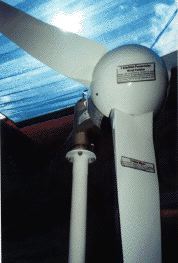 (click
to see larger image)
(click
to see larger image)
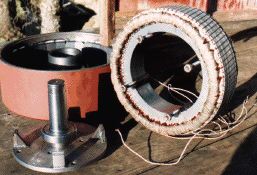 Here
are parts of the alternator. The magnet rotor (top left) is
cast
from iron. It runs on the main shaft. The blades are bolted
to the face this rotor. Inside the rotor are ferrite permanent
magnets.
The magnets move past the laminated core of the stator which contains
stationary
coils of copper wire. On the right you can
see the stator being wound.
Here
are parts of the alternator. The magnet rotor (top left) is
cast
from iron. It runs on the main shaft. The blades are bolted
to the face this rotor. Inside the rotor are ferrite permanent
magnets.
The magnets move past the laminated core of the stator which contains
stationary
coils of copper wire. On the right you can
see the stator being wound.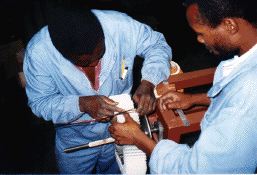
The alternator is heavy because it has many magnets and coils in
it.
Lighter alternators generally run at higher speed. These lighter
wind turbines are noisier and wear themselves out sooner.
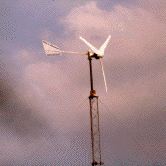 Click to see an
enlarged picture.
Click to see an
enlarged picture. 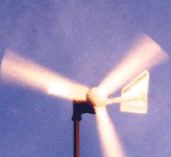 The
wind turbine is protected against high winds by a simple, passive
system
which has been tested in winds exceeding 100mph, without incident.
The
wind turbine is protected against high winds by a simple, passive
system
which has been tested in winds exceeding 100mph, without incident.
As wind grows stronger, and maximum power is reached, the turbine is
'yawed' sideways from the wind. This prevents the blades from
overspeeding.
There a minimum of moving parts involved.. no springs.. no highly
stressed
components.(click)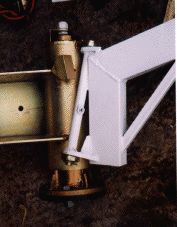
Mick Sagrillo writes about
the
AWP 3.6:
This is a very simple machine that does what it is supposed to
do.
It is quite heavy duty and build to last a long time. The turbine
is easy to install, with simple tools. I am most impressed with
the
turbine’s slow speed and quiet operation. It is refreshing to see
that a modern wind generator can be manufactures that is absolutely
quiet
in its operation.
This is a very nice machine. I only wish someone in
the
US
could build something as good as the AWP. We could use the
competition, to
say the least. And the low speed reliability. This is
heavy metal, which
is right in line with my ideas on wind turbine design. Nice
job!!!
 The
AWP website in 2009
The
AWP website in 2009
 The
AWP website in 2009
The
AWP website in 2009